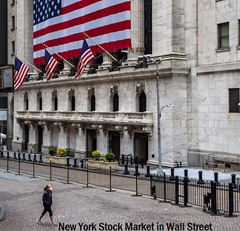The Economist looks at the dangerous gap between America’s stockmarket and the economy. In the past few weeks a gut-wrenching sell-off in shares has been followed by a delirious rally. Between February 19th and March 23rd, the S&P 500 index lost a third of its value. With barely a pause it has since rocketed, recovering more than half its loss. At one level, this makes good sense. Asset managers have to put money to work as best they can. But there is something wrong with how far stock prices have moved. American shares are now higher than they were in August, suggesting that the economy can get back to business as usual. There are countless threats to such a prospect, starting with how far the rosy view on Wall Street is from life on Main Street, where people are out of work, small businesses are struggling to get cash and there is the ever-present threat of a second wave of the coronavirus pandemic.
The Markets vs the real Economy 
May 7.– Stockmarket history is packed with drama: the 1929 crash; Black Monday in 1987, when share prices lost 20% in a day; the dotcom mania in 1999. With such precedents, nothing should come as a surprise, but the past eight weeks have been remarkable, nonetheless. A gut-wrenching sell-off in shares has been followed by a delirious rally in America. Between February 19th and March 23rd, the s&p 500 index lost a third of its value. With barely a pause it has since rocketed, recovering more than half its loss. The catalyst was news that the Federal Reserve would buy corporate bonds, helping big firms finance their debts. Investors shifted from panic to optimism without missing a beat.
This rosy view from Wall Street should make you uneasy (see article). It contrasts with markets elsewhere.
Shares in Britain and continental Europe, for example, have recovered more sluggishly. And it is a world away from life on Main Street. Even as the lockdown eases in America, the blow to jobs has been savage, with unemployment rising from 4% to about 16%, the highest rate since records began in 1948. While big firms’ shares soar and they get help from the Fed, small businesses are struggling to get cash from Uncle Sam.
Wounds from the financial crisis of 2007-09 are being reopened. “This is the second time we’ve bailed their asses out,” grumbled Joe Biden, the Democratic presidential candidate, last month. The battle over who pays for the fiscal burdens of the pandemic is just beginning. On the present trajectory, a backlash against big business is likely.
Start with events in the markets. Much of the improved mood is because of the Fed, which has acted more dramatically than other central banks, buying up assets on an unimagined scale. It is committed to purchasing even more corporate debt, including high-yield “junk” bonds. The market for new issues of corporate bonds, which froze in February, has reopened in spectacular style. Companies have issued $560bn of bonds in the past six weeks ...
[ Full text ]
Comments powered by CComment